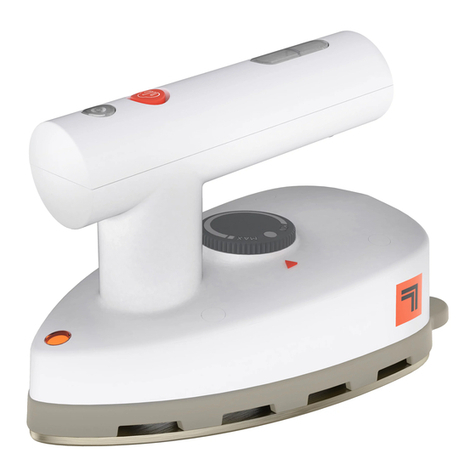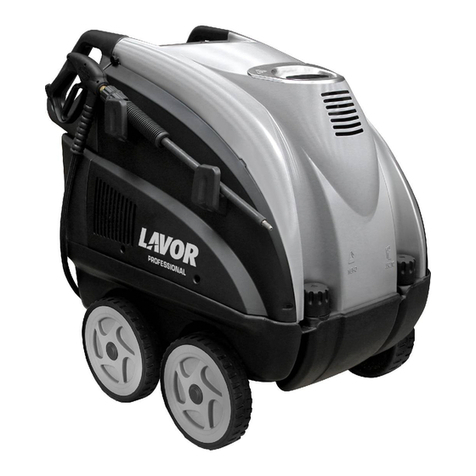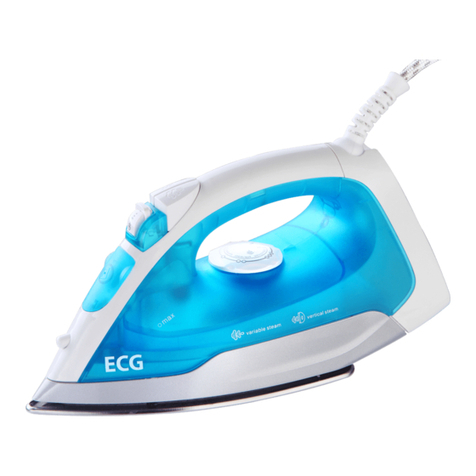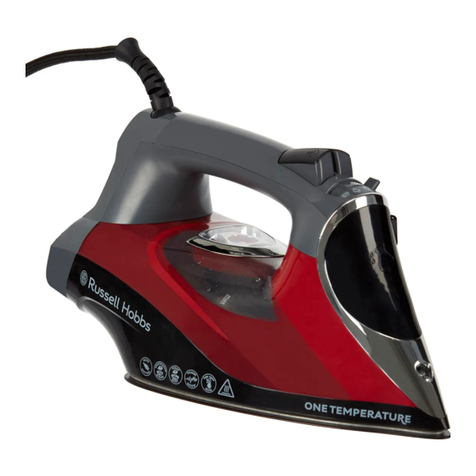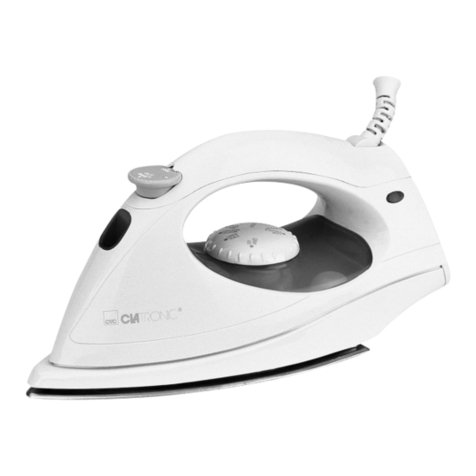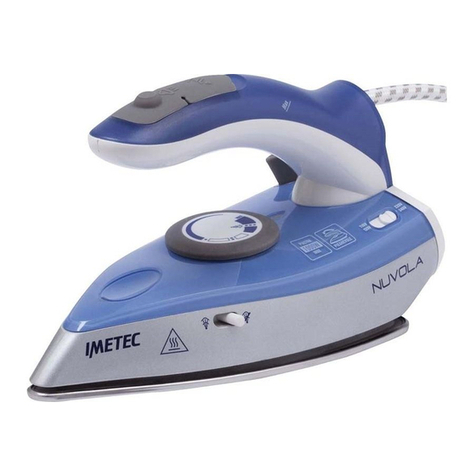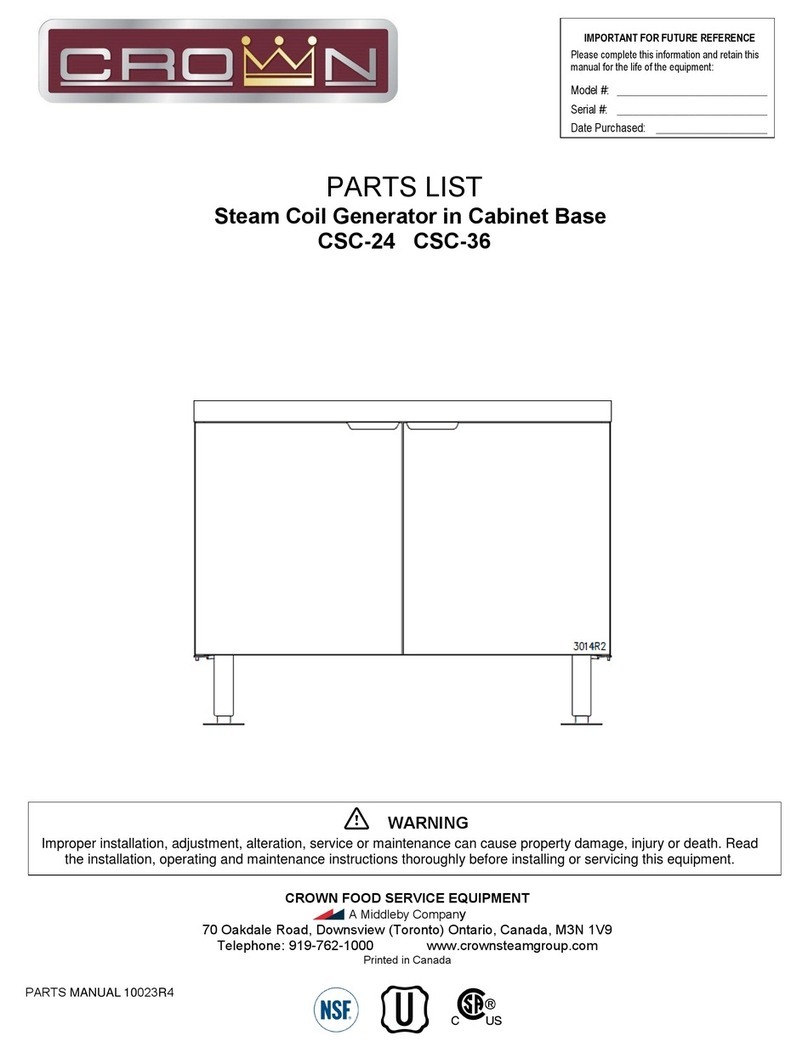
54
We recommend that you:
• Start by ironing those items of laundry that require the lowest temperature (e.g.
synthetics). Finish by ironing fabrics which respond best to higher temperatures
and steam—such as cotton and linen.
• If you iron a fabric made of a blend of bres set the temperature of your iron to the
most delicate bre.
• Never use the burst of steam button on silks or synthetics.
• When using starch, it should be sprayed onto the reverse side of the fabric and
the soleplate cleaned more frequently.
• Do not iron over sharp or hard objects such as buttons, studs or zippers as they
will scratch the soleplate of your iron.
• Your iron takes time to heat up and cool down. If you change the temperature
setting on your iron, you must give it time to adjust to the new setting.
• This is especially important when you change from a high setting to a lower one. It
takes your iron longer to cool down than it does to heat up and this is the reason
we recommend that you begin ironing at lower temperatures.
Ironing without steam
If you intend to dry-iron fabrics there is no need to ll the water tank. However, if water
is already in the water tank, you don’t need to empty it.
1. Set the steam control e to the no steam position (0).
2. Plug your iron into the mains supply and switch on.
3. Rotate the temperature control ountil the desired setting is aligned with the dial pointer.
4. The temperature indicator light s will come on, indicating that the iron is heating
up. When the light turns off, the set temperature has been reached and your iron
is ready to use.
Steam ironing
During steam ironing, if you do not allow your iron to reach the
selected temperature water may drip from the soleplate.
It is recommended that for harder to iron fabrics such as cotton and linen, steam should
be used when ironing.
When ironing cotton and linen, always select the highest temperature. Steam should
never be used on delicate fabrics like nylons, acrylics and synthetics.
1. Fill your iron with water.
2. Plug your iron into the mains supply and switch on.
3. Set the temperature control oto the lll setting. The hotter your iron, the more
steam is generated.
4. The temperature indicator light s will come on, indicating that the iron is heating
up. When the temperature indicator light turns off, the set temperature has been
reached and your iron is ready to use. The temperature indicator light will turn on
and off during ironing as your iron maintains the correct temperature.
5. Adjust the steam control e to select the desired steam output.
6. Move the steam control to the high steam ( ) setting to increase the amount of
steam, or towards the off (0) setting to decrease the amount of steam.
7. The steam can be shut off at any time by setting the steam control to the off (0) position.
Burst of steam
The temperature control dial must be set within the ll and lll setting. Wait
several seconds between each press of the steam button.
Press the shot of steam button r whenever you have a stubborn crease that needs
extra steam. Steam will burst from the holes in the soleplate of your iron into the fabric.
Vertical steam ironing
Never iron garments when they are being worn.
1. Prepare your iron as for steam ironing.
2. Hold your iron 15cm from the fabric.
3. Press the shot of steam button r as required. Wait several seconds between
each press of the button.
Spraying
The water spray can be used to help iron heavy fabrics or difcult areas (collars,
pockets, sleeves, creases, etc). It can also be used when ironing delicate fabrics which
cannot be steam ironed.
Make sure there is water in the tank. Press the spray button tto produce a spray of water.
Anti-drip feature
When the temperature of your iron is insufcient to create steam, the supply of water is
cut off automatically to avoid any drips from the soleplate.
Anti-scale lter
Your iron is tted with a permanent anti-scale lter. This lter is xed and cannot be
removed for cleaning.
The lter is designed to reduce the build-up of limescale inside your iron. Limescale
occurs during steam ironing due to water hardness.
Water hardness varies from one area to another. The effectiveness of the lter will
depend on how ‘hard’ your water is.
Auto shut off feature
An electronic safety device will automatically switch the heating element off if the iron
has not been moved more than 30 seconds in a horizontal position. If in a vertical
position, this will happen after 15 minutes. To indicate that the heating element has
been switched off, the power light y will start blinking.
When picking up the iron again, the power light will stop blinking and illuminate solid.
The temperature indicator light s will turn on. This indicates that the iron is heating up
again. Wait for the temperature light to turn off. Then the iron is ready for use.
Care and Cleaning
Warning: Do not use harsh abrasives, chemical cleaners or solvents to clean
the exterior of your iron. Do not immerse the appliance or power cord and plug in
water or any other liquid.
Allow your iron to completely cool down and wipe the soleplate with a soft damp cloth. If
polyester has burnt to the soleplate, iron a damp cotton cloth while your iron is still hot.
Wipe over the rest of your iron with a soft damp cloth then wipe dry.
VIN405_VIN438_22EM2 (UK).indd 4-5VIN405_VIN438_22EM2 (UK).indd 4-5 6/23/2022 9:00:43 AM6/23/2022 9:00:43 AM



































